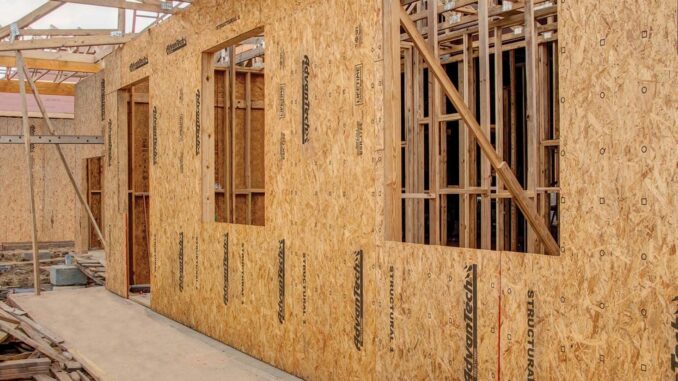
When embarking on a construction project, whether it’s building a home, a commercial space, or even a renovation, the materials you choose play a pivotal role in the overall outcome. One of the essential materials in this context is sheathing plywood. This type of plywood is used in a variety of applications to provide structural integrity and protection for buildings. But what exactly is sheathing plywood, and why is it crucial for your construction projects? This comprehensive guide will cover everything you need to know, from types and specifications to installation and maintenance. Let’s dive into the details and explore the key aspects of sheathing plywood.
Definition of Sheathing Plywood
Sheathing plywood is a specialized type of plywood primarily used in construction to cover, support, and protect structural components of buildings. It forms an integral part of the framing system, covering wooden or steel studs to provide a solid base for exterior surfaces. Whether it’s used in wall, roof, or floor applications, sheathing plywood is designed to bear loads, resist the elements, and improve the overall stability of the structure. It is essential for preventing moisture infiltration, offering insulation, and contributing to the overall safety and durability of the building.
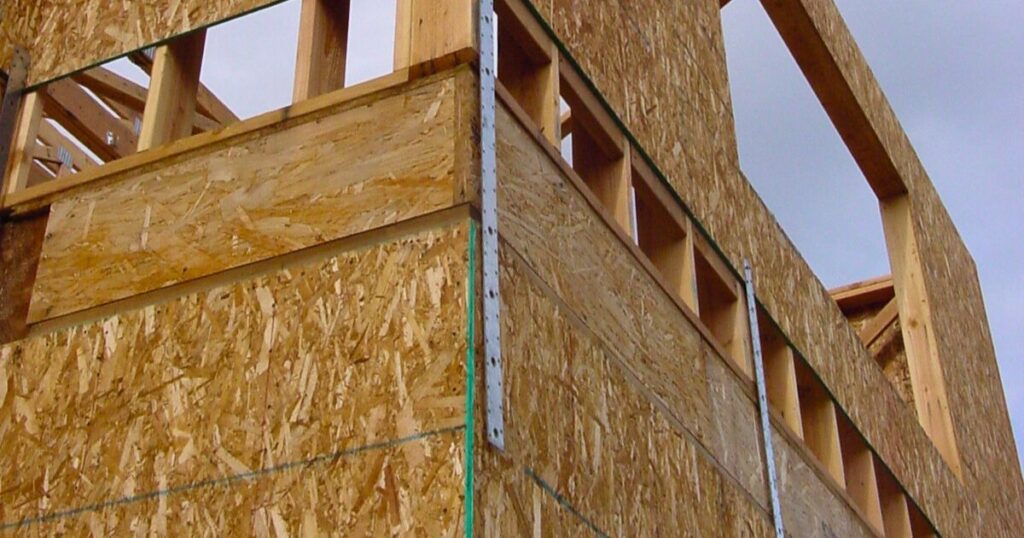
What is Sheathing Plywood?
So, what exactly is sheathing plywood? Essentially, sheathing plywood is a wood-based panel that serves as a protective and structural covering on the exterior or interior of buildings. It is made by gluing together multiple layers of wood veneers, with each layer placed perpendicular to the previous one to enhance strength and minimize the chance of warping. These sheets of plywood come in varying thicknesses, grades, and sizes, all tailored to meet the requirements of the construction project.
Sheathing plywood is widely used because of its unique combination of structural strength, flexibility, and resistance to wear and environmental stress. Its role extends beyond just covering frames—sheathing plywood helps stabilize the building, protecting it from weather, insulating it against temperature extremes, and providing a base for exterior finishes such as siding or shingles. The ability to act as a reliable structural layer makes it an indispensable material in residential, commercial, and industrial construction.
Distinction Between Sheathing Plywood and Other Types of Plywood
Though all plywood shares the fundamental construction of thin, laminated wood layers, sheathing plywood has distinct features that set it apart from other types of plywood like furniture-grade or decorative plywood. The most significant differences are:
- Thickness and Strength: Sheathing plywood is typically thicker and stronger than decorative plywood. It is built to withstand environmental stresses such as wind, rain, and snow, as well as the weight of the structure itself.
- Moisture Resistance: Many types of sheathing plywood are treated or manufactured to resist moisture, making them ideal for external applications. Other plywood variants may not have this feature.
- Surface Appearance: Unlike furniture-grade plywood, which is chosen for its smooth, blemish-free surface, sheathing plywood may have a rougher finish and visible knots, as the appearance is less important for structural purposes.
Understanding these differences is crucial when choosing plywood for a construction project, as selecting the wrong type could affect both the safety and longevity of the structure.
You might be interested in this article: RTD Plywood vs CDX Plywood
Importance of Sheathing Plywood in Construction
Sheathing plywood is an essential component of modern construction because it provides several important benefits:
- Structural Integrity: The primary purpose of sheathing plywood is to offer strength and stability to the framework of a building. It helps ensure that walls, roofs, and floors remain intact under pressure, both from environmental forces and weight loads.
- Protection Against Weather Elements: Sheathing plywood acts as a barrier between the exterior elements and the interior of the building. It protects the underlying structural components from moisture, which could cause rot, mold, and other forms of damage. This is particularly vital in regions with harsh weather conditions.
- Insulation and Energy Efficiency: Plywood used for sheathing can contribute to a building’s energy efficiency by acting as a thermal barrier. When combined with insulation, it can help maintain a comfortable indoor temperature and reduce energy consumption.
- Safety: Sheathing plywood helps prevent the spread of fire and provides resistance to wind and other environmental pressures. It is a crucial element in meeting building codes and ensuring that the structure remains secure during extreme conditions.
Common applications of sheathing plywood can be found in residential homes, commercial buildings, warehouses, and industrial structures. Its versatility and crucial role in construction make it a go-to material for builders worldwide.
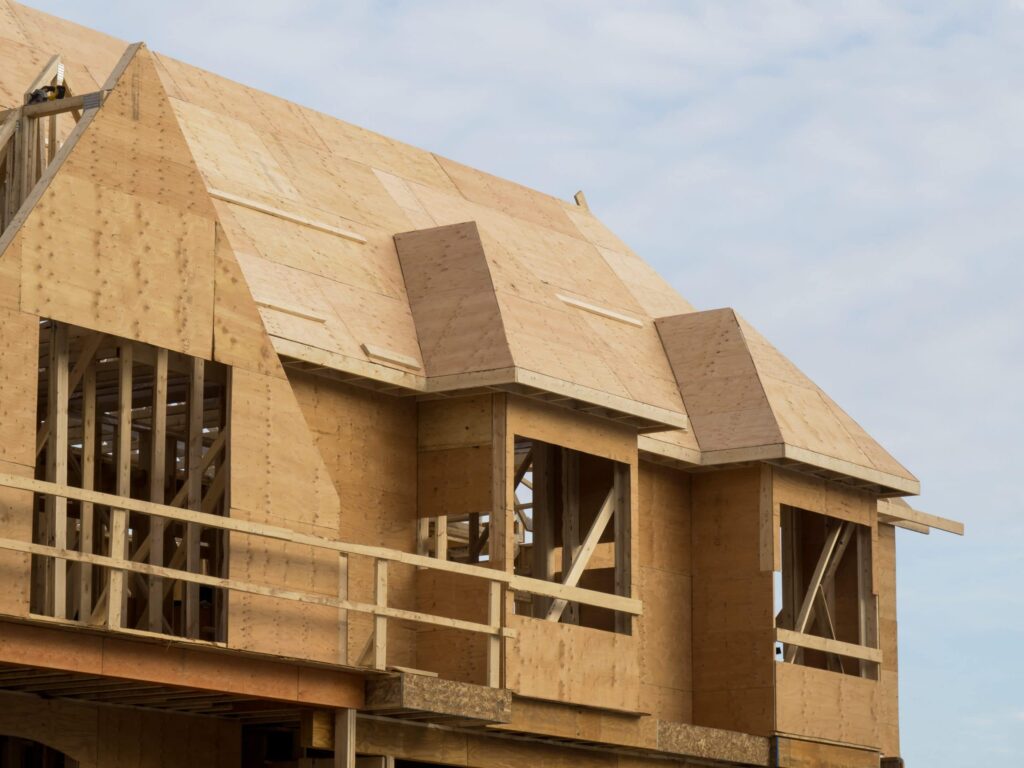
Types of Sheathing Plywood
Standard Plywood
Standard plywood is commonly used in construction for sheathing purposes. It consists of layers of wood veneers glued together, with each layer running perpendicular to the previous one for added strength and stability. This type of plywood is typically used in interior applications or for non-exposed areas.
- Description and Uses: Standard plywood can be used for walls, floors, and roof sheathing in areas that are not exposed to excessive moisture or harsh weather conditions. It’s strong enough to support the weight of the structure and offer a solid base for flooring or roofing materials.
- Features like Durability and Moisture Resistance: While standard plywood is durable, it may not be as resistant to moisture as exterior-grade plywood. In regions with high humidity or wet conditions, additional treatment may be needed to ensure that it remains strong and intact.
Exterior Plywood
Exterior plywood is specifically designed for use in areas exposed to the elements. This type of plywood is treated to resist moisture, making it ideal for outdoor applications.
- Characteristics of Exterior-Grade Plywood: Exterior plywood is manufactured with waterproof glue and may feature additional treatments such as pressure impregnation with preservatives. This makes it highly resistant to moisture, mold, mildew, and rot, ensuring long-lasting performance in outdoor applications.
- Applications in Weather-Exposed Areas: Exterior plywood is commonly used for wall sheathing, roof decking, and as a base layer for cladding materials in buildings that will be exposed to rain, snow, or other weather conditions.
Structural Plywood
Structural plywood is a heavy-duty type of plywood designed to meet the needs of load-bearing applications. It is typically used in areas where the material must support significant weight and stresses, such as in floors, roofs, and walls.
- Uses in Load-Bearing Applications: Structural plywood is perfect for flooring in multi-story buildings, roofing systems, and exterior wall sheathing. Its superior strength and performance make it ideal for projects that demand a high level of structural integrity.
- Code Compliance and Structural Strength: Structural plywood complies with specific building codes and regulations that dictate the materials’ load-bearing capacity. These codes are essential for ensuring that the building is safe and structurally sound.
OSB (Oriented Strand Board) vs. Plywood
OSB is another popular material used for sheathing, and it is often compared to plywood. Though both are engineered wood products, there are notable differences between them.
- Differences in Material Composition and Properties: OSB is made from large wood chips or strands that are glued together under heat and pressure. In contrast, plywood is made from thin layers of wood veneer that are laminated together. The result is a more uniform structure in plywood compared to OSB, which may have a rougher appearance.
- Advantages and Disadvantages of OSB vs. Plywood for Sheathing: OSB is generally cheaper than plywood and performs well in load-bearing applications. However, it is more susceptible to moisture damage and may not be as durable as plywood. Additionally, OSB tends to have a rougher surface and may not be as aesthetically pleasing for exposed applications. For projects where appearance is important or in areas exposed to moisture, plywood is often the preferred choice.
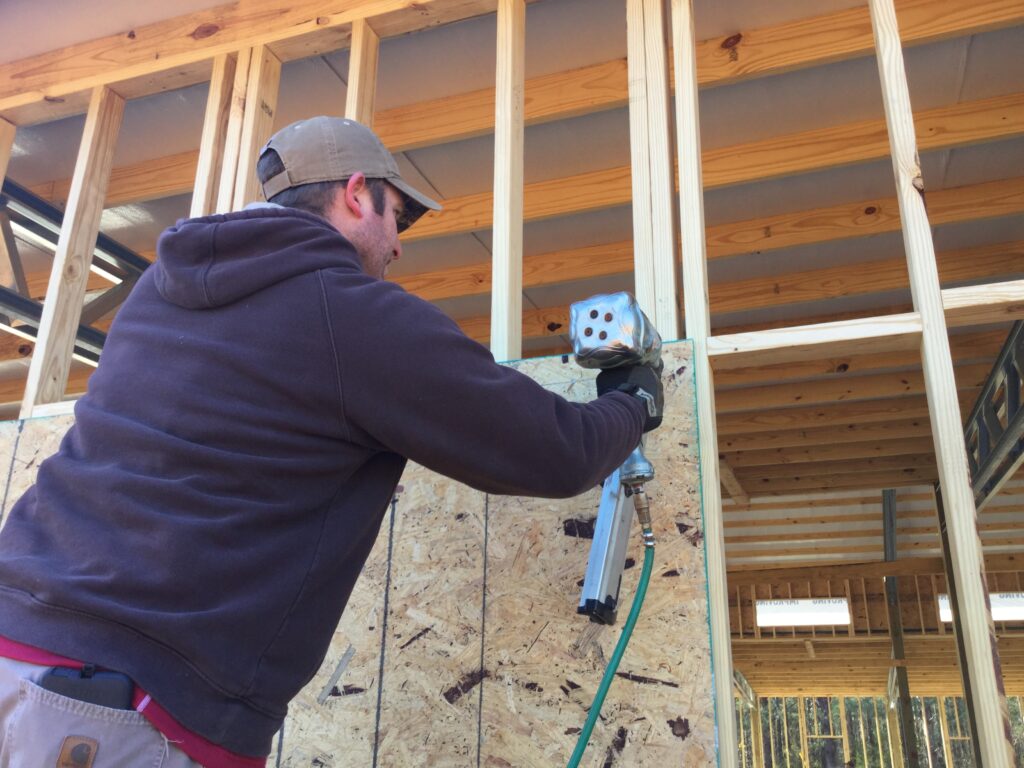
Specifications and Standards
Grading System for Sheathing Plywood
Plywood is graded according to its quality, with different grades indicating the strength, appearance, and durability of the material. The grading system typically involves letters such as A, B, C, and D, with each letter representing a different level of quality.
- Explanation of Grades (e.g., A, B, C, D): Grade A plywood is the highest quality and has a smooth surface with minimal defects. Grade B plywood may have some knots or blemishes but still offers good structural integrity. Grade C and D plywood have more visible defects and are typically used in areas where appearance is not a priority, but strength is still required.
- Understanding the Impact of Grade on Durability and Strength: The grade of plywood directly affects its performance. Higher grades are suitable for exterior applications or areas that require maximum strength, while lower grades can be used for hidden or non-structural applications.
You might be interested in this article: What is ACX Plywood?
Thickness and Size Considerations
The thickness and size of the plywood sheets you choose will depend on the specific needs of your project. Different applications call for varying thicknesses of plywood.
- Standard Thickness Options (e.g., 1/4″, 3/8″, 1/2″, etc.): Plywood thickness typically ranges from 1/8 inch to 1 inch or more. Thicker sheets are used in load-bearing applications, while thinner sheets are used for wall cladding or non-structural purposes.
- Recommended Thicknesses for Different Applications: For roof sheathing, a thickness of 3/8 to 1/2 inch is generally sufficient. For wall sheathing, 1/4 to 3/8 inch plywood is commonly used. Floor sheathing typically requires thicker plywood, ranging from 1/2 to 3/4 inch, depending on the load it needs to support.
Moisture Resistance and Treatment
Plywood used for sheathing is often exposed to moisture, which can lead to warping, swelling, or rot if not properly treated.
- How Moisture Affects Plywood and the Need for Treated Materials: When plywood absorbs moisture, it can lose its structural integrity and become vulnerable to mold and decay. To combat this, sheathing plywood is often treated with moisture-resistant chemicals or coatings that prevent water infiltration.
- Types of Treatments Available (e.g., Pressure-Treated Plywood): Pressure-treated plywood is impregnated with preservative chemicals under high pressure, making it resistant to moisture, mold, and insects. This type of plywood is ideal for exterior applications where it will be exposed to the elements.
Strength Ratings and Load-Bearing Capacities
Strength ratings indicate how much weight plywood can support. These ratings are particularly important for structural applications.
- Overview of Load Ratings like PS1 and PS2: Plywood designed for sheathing is rated according to the PS1 (for structural plywood) or PS2 (for general plywood). These ratings are based on the material’s ability to handle specific loads, such as wind pressure or the weight of roofing materials.
- Importance of Adhering to Building Codes: It is crucial to select plywood that meets the appropriate strength rating for the intended application. Using substandard plywood in structural applications could lead to safety risks, making it essential to follow building codes and regulations.
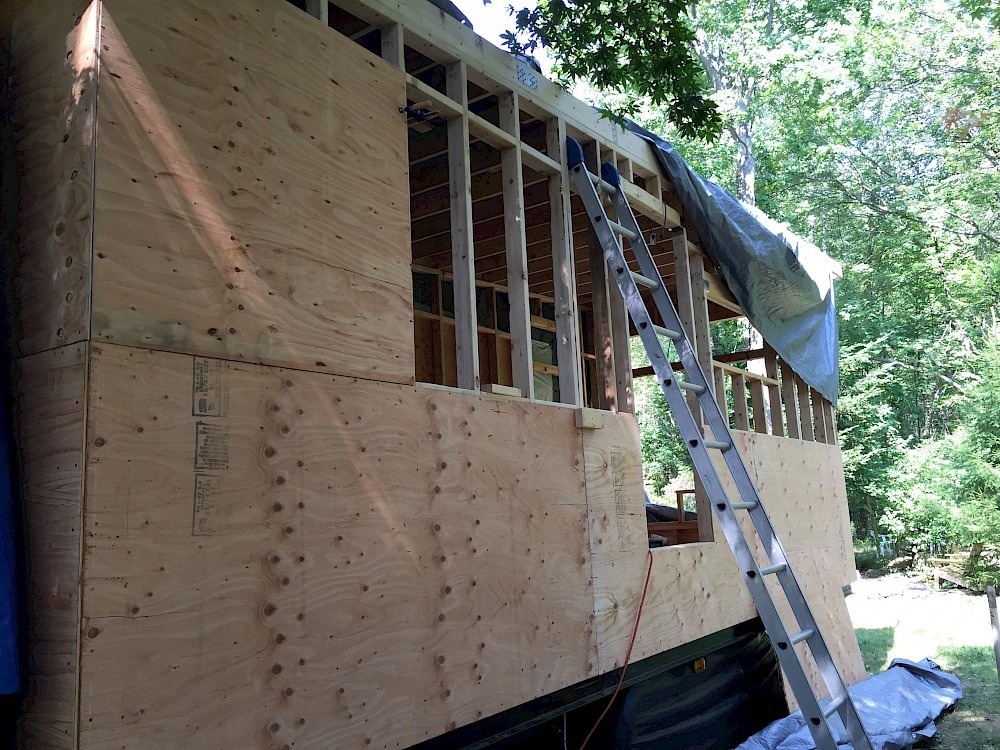
Applications of Sheathing Plywood
Roof Sheathing
Roof sheathing is one of the most common applications of plywood in construction. It provides a solid base for roofing materials such as shingles, tiles, or metal panels.
- Why Plywood is Commonly Used for Roof Decking: Plywood is the material of choice for roof sheathing because of its strength, ease of installation, and versatility. It can withstand the forces of wind, snow, and other environmental stresses while providing a sturdy base for roofing materials.
- Considerations for Wind, Snow, and Other Load Factors: When selecting plywood for roof sheathing, it is essential to consider the weight of roofing materials, snow load, and wind resistance. Plywood’s strength makes it a reliable option for these applications.
Wall Sheathing
Sheathing plywood is also used extensively in wall construction. It serves as a protective barrier against moisture and weather elements while providing structural support.
- Protection of Structural Elements from Weather and Moisture: Plywood wall sheathing is an essential layer in keeping the interior of the building safe from water damage. It prevents rain, snow, or moisture from reaching the framing and insulation, which could cause damage over time.
- Integration with Insulation and Vapor Barriers: Plywood sheathing works in tandem with insulation and vapor barriers to create an energy-efficient building. This combination helps regulate temperature and humidity levels, improving the comfort and longevity of the structure.
Floor Sheathing
Floor sheathing forms the base layer for subfloors and provides structural support for the finished flooring material.
- Use in Subflooring for Load-Bearing Floors: Plywood is commonly used for floor sheathing because it offers exceptional strength and stability. It forms the foundation for tiles, carpet, hardwood, or other flooring materials.
- Benefits of Plywood Over Other Materials for Floors: Compared to OSB or MDF, plywood is more durable and resistant to moisture, making it the superior choice for floor sheathing. It also has better load-bearing properties, ensuring the floor remains strong and stable over time.
You might be interested in this article: Can Plywood Get Wet?
Exterior Applications
Plywood is also an excellent choice for exterior applications such as cladding and siding. It provides a durable and weather-resistant surface for the outer walls of the building.
- Cladding and Siding Considerations: Plywood can be used as an outer layer of cladding that provides protection from the elements while also contributing to the building’s aesthetic appeal. It is often painted or finished to enhance its resistance to weather.
- Exposure to Harsh Weather and How Plywood Withstands These Conditions: When treated for moisture resistance, exterior plywood is capable of withstanding rain, wind, and temperature fluctuations without losing its structural integrity.
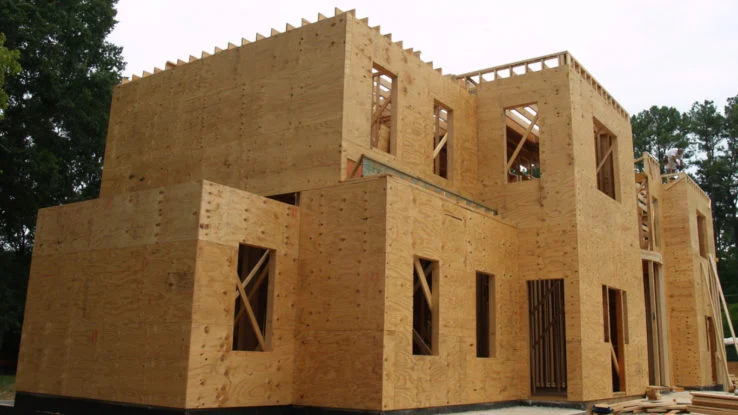
Installation of Sheathing Plywood
Preparation Before Installation
Before installing sheathing plywood, proper preparation of the site is necessary to ensure the material performs as expected.
- Site Preparation (e.g., Clearing, Ensuring Proper Moisture Conditions): The site should be thoroughly cleared of debris, and the framing should be checked for level and moisture content. It is essential to ensure that the wood framing is dry to prevent any water from affecting the plywood during installation.
- Checking Plywood for Defects: Each sheet of plywood should be inspected for defects, including warping, cracks, or voids, which could compromise its structural integrity.
Tools and Materials Needed
To properly install sheathing plywood, you’ll need specific tools and materials.
- List of Essential Tools (e.g., Saws, Hammers, Nails, Adhesive): Essential tools include a circular saw or handsaw for cutting plywood, a hammer or pneumatic nail gun for fastening, and adhesive for additional bonding if necessary.
- Types of Nails and Fasteners Suitable for Sheathing: Use galvanized or stainless steel nails to avoid corrosion. The nails should be long enough to secure the plywood to the framing but not too long to penetrate through the other side of the wall or roof.
Step-by-Step Installation Process
The installation of sheathing plywood is straightforward but requires attention to detail to ensure it is properly secured and aligned.
- How to Measure and Cut Plywood Sheets: Measure the dimensions of the wall, roof, or floor before cutting the plywood to fit. Use a saw to trim the edges of each sheet so that it fits snugly between studs or rafters.
- Proper Nailing Patterns and Spacing: Follow the recommended nailing pattern for your region and project specifications. Typically, nails are spaced 6 inches apart along the edges and 12 inches apart in the center of the sheet to ensure a secure hold.
Maintenance and Durability
Weatherproofing and Protective Coatings
For maximum longevity, it is important to apply protective coatings to sheathing plywood.
- Sealing the Edges and Surface: Applying a weatherproofing sealer or finish can help protect plywood from moisture damage. Special attention should be given to the edges, as these areas are more susceptible to water infiltration.
- Paint and Stain Options: Using high-quality exterior paint or stain not only enhances the appearance of the plywood but also provides an additional layer of protection against moisture, UV rays, and general wear and tear.
Longevity and Maintenance Tips
Maintaining the sheathing plywood is vital to preserving the structural integrity of the building.
- Regular Inspections: Check for signs of moisture damage, warping, or cracking. If the plywood appears compromised, it may need to be replaced or treated.
- Timely Repairs: Address any issues immediately to prevent further damage and extend the life of the sheathing.
Conclusion
Sheathing plywood plays a fundamental role in construction, offering strength, protection, and insulation for buildings. Understanding its various types, specifications, and proper installation techniques ensures that the material performs as expected, contributing to the safety and longevity of the structure. By choosing the right sheathing plywood for your project and maintaining it properly, you can ensure that your building stands strong and secure for years to come.